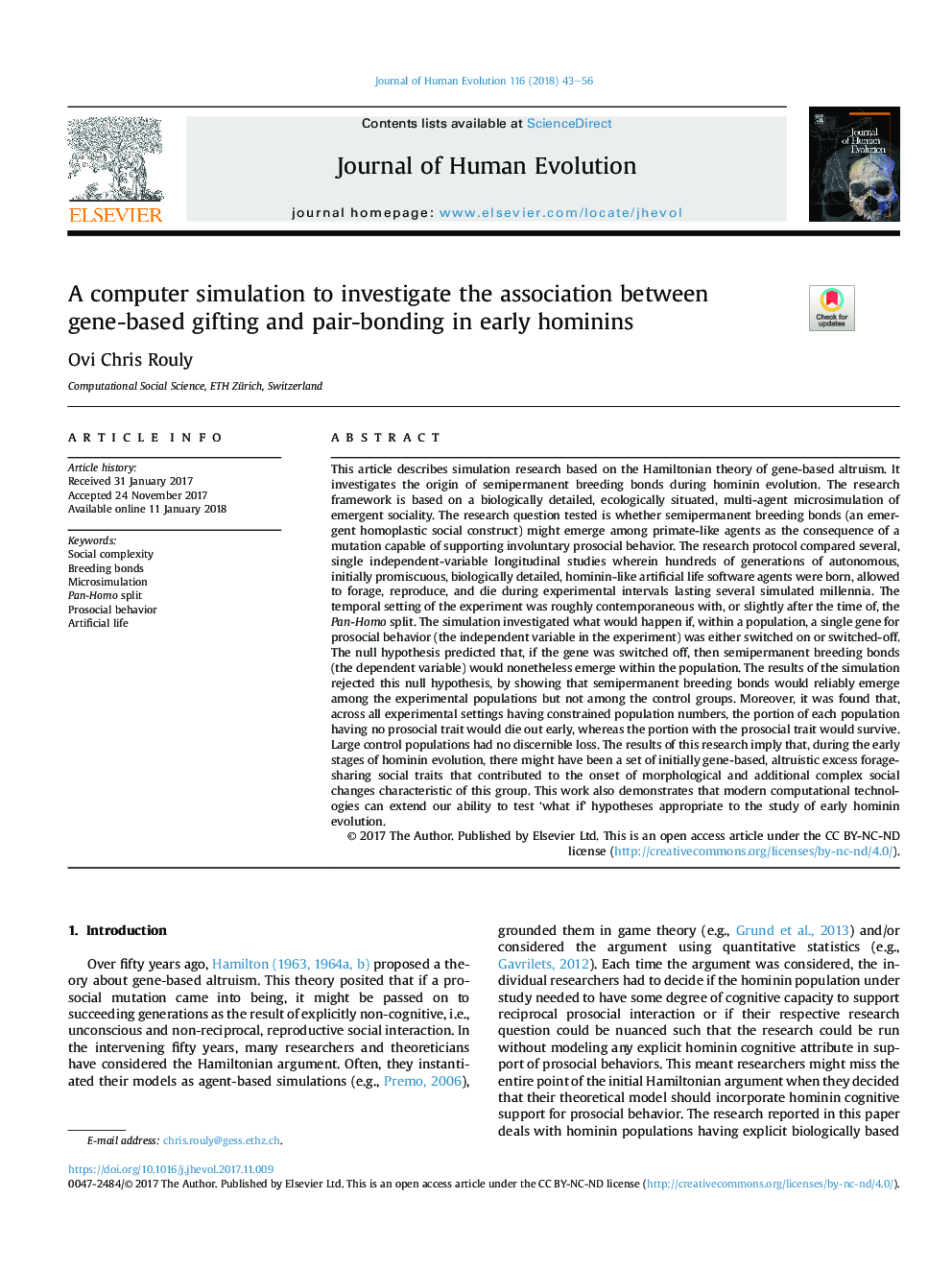| کد مقاله | کد نشریه | سال انتشار | مقاله انگلیسی | نسخه تمام متن |
|---|---|---|---|---|
| 8887301 | 1628133 | 2018 | 14 صفحه PDF | دانلود رایگان |
عنوان انگلیسی مقاله ISI
A computer simulation to investigate the association between gene-based gifting and pair-bonding in early hominins
ترجمه فارسی عنوان
یک شبیه سازی کامپیوتری برای بررسی رابطه بین هدیه مبتنی بر ژنی و پیوند زوج در اوایل انسان
دانلود مقاله + سفارش ترجمه
دانلود مقاله ISI انگلیسی
رایگان برای ایرانیان
کلمات کلیدی
پیچیدگی اجتماعی، پرورش اوراق قرضه، میکروسیمولت، پان هومو تقسیم، رفتار طرفدار زندگی مصنوعی،
ترجمه چکیده
این مقاله، تحقیق شبیه سازی را بر اساس نظریه همیلتون در مورد نوع دوست یابی مبتنی بر ژن توصیف می کند. این منبع منشاء پیوند های پرورش نیمه پایانی را در طول تکامل هومیین بررسی می کند. چارچوب تحقیق مبتنی بر یک مکمل بیولوژیکی، محیط زیستی و چندگانه مکانیسم اجتماعی اجتماعی است. مساله تحقیق مورد بررسی قرار گرفته است این است که آیا می توان از طریق یک جهش که قادر به حمایت از رفتارهای غیرمستقیم طرفدارانه است، ممکن است در میان عوامل ناشناخته به مثابه یک اجباری به وجود آید. پروتکل تحقیق، مطالعات طولی چندین متغیر مستقل را در بر داشت که در آن صدها نسل از عاملهای نرم افزاری خودمختار، ابتدایی، بیولوژیکی و منحصر به فرد مانند زندگی انسان مصنوعی متولد شده، مجاز به علوفه، تکثیر و مرگ در طی دوره های آزمایشی چند هزار ساله شبیه سازی شده . محدوده زمانی آزمایش تقریبا همزمان با یا تقریبا بعد از زمان پان هومو بود. شبیه سازی بررسی کرد چه اتفاقی خواهد افتاد اگر در یک جمعیت یک ژن واحد برای رفتار طرفدار (متغیر مستقل در آزمایش) یا روشن یا خاموش شود. فرضیه صفر پیش بینی کرد که اگر ژن خاموش شود، سرانجام پرورش پرندگان نیمه رسمی (متغیر وابسته) در میان جمعیت رخ می دهد. نتایج شبیه سازی این فرضیه صفر را رد کرد، نشان می دهد که پیوند های پرورش نیمه پایانی به طور قابل اعتماد در میان جمعیت های آزمایشی، اما نه در میان گروه های کنترل ظاهر می شود. علاوه بر این، مشخص شد که در میان تمام تنظیمات آزمایشی که دارای تعداد محدودی از جمعیت هستند، بخشی از هر جمعیت که دارای هیچ ویژگی خاص نیستند، زودتر از بین می روند، در حالی که بخش با صفات طرفدار اجتماعی می تواند زنده بماند. جمعیت های کنترل بزرگی از بین رفت. نتایج این تحقیق به این معنی است که در مراحل اولیه تکامل هومیین ممکن است مجموعه ای از صفات اجتماعی که در ابتدا به صورت ژنتیکی و غیرقابل جبران بیش از حد علوفه به اشتراک گذاشته شده است، کمک کند که به ایجاد تغییرات مورفولوژیکی و پیچیده اجتماعی پیچیده ای که به این امر منجر می شود، گروه این کار همچنین نشان می دهد که فن آوری های محاسباتی مدرن می توانند توانایی ما را برای تست فرضیه های «چه چیزی اگر» برای مطالعه تکامل اولیه هومیین مورد آزمایش قرار دهند.
موضوعات مرتبط
علوم زیستی و بیوفناوری
علوم کشاورزی و بیولوژیک
بوم شناسی، تکامل، رفتار و سامانه شناسی
چکیده انگلیسی
This article describes simulation research based on the Hamiltonian theory of gene-based altruism. It investigates the origin of semipermanent breeding bonds during hominin evolution. The research framework is based on a biologically detailed, ecologically situated, multi-agent microsimulation of emergent sociality. The research question tested is whether semipermanent breeding bonds (an emergent homoplastic social construct) might emerge among primate-like agents as the consequence of a mutation capable of supporting involuntary prosocial behavior. The research protocol compared several, single independent-variable longitudinal studies wherein hundreds of generations of autonomous, initially promiscuous, biologically detailed, hominin-like artificial life software agents were born, allowed to forage, reproduce, and die during experimental intervals lasting several simulated millennia. The temporal setting of the experiment was roughly contemporaneous with, or slightly after the time of, the Pan-Homo split. The simulation investigated what would happen if, within a population, a single gene for prosocial behavior (the independent variable in the experiment) was either switched on or switched-off. The null hypothesis predicted that, if the gene was switched off, then semipermanent breeding bonds (the dependent variable) would nonetheless emerge within the population. The results of the simulation rejected this null hypothesis, by showing that semipermanent breeding bonds would reliably emerge among the experimental populations but not among the control groups. Moreover, it was found that, across all experimental settings having constrained population numbers, the portion of each population having no prosocial trait would die out early, whereas the portion with the prosocial trait would survive. Large control populations had no discernible loss. The results of this research imply that, during the early stages of hominin evolution, there might have been a set of initially gene-based, altruistic excess forage-sharing social traits that contributed to the onset of morphological and additional complex social changes characteristic of this group. This work also demonstrates that modern computational technologies can extend our ability to test 'what if' hypotheses appropriate to the study of early hominin evolution.
ناشر
Database: Elsevier - ScienceDirect (ساینس دایرکت)
Journal: Journal of Human Evolution - Volume 116, March 2018, Pages 43-56
Journal: Journal of Human Evolution - Volume 116, March 2018, Pages 43-56
نویسندگان
Ovi Chris Rouly,
